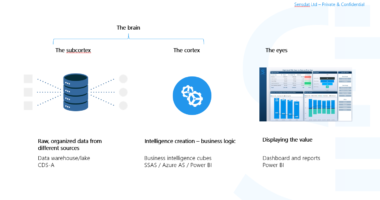“We went from nowhere in 2015 to being the leader in cloud Business Intelligence within 3 years.” Satya Nadella, Microsoft CEO.
When you look at the Power BI team’s pace of execution, and the low price point of the Power BI platform, it’s hardly surprising to see so much hype around Microsoft’s analytics suite in the modern BI market. Indeed, when looking for a serious BI tool, corporations now turn to Power BI just as they would have once turned to Tableau or Qlikview, the two other leaders in this year’s Gartner Magic BI & Analytics quadrant.

In the span of 3 years, Microsoft has caught up with Tableau and Qlik, both great and mature analytics platforms. On the “ground”, we are seeing something even more interesting: we are working with companies to replace Tableau or Qlik, once seen as the gold standard up until about a year ago, with none other than Power BI. Why is that?
Besides some obvious reasons in terms of implementation process (you need an expert company to implement analytics if you want to make the most out of the technology), Power BI – and more generally the full Azure analytics suite – are so flexible that they help solve almost anything, starting with basic reporting automation, the creation of key business insights, and the ease of sharing these new metrics. This enables companies to empower every person of their organisation from the managers to the analysts, to the people working on the field (e.g. sales reps, warehouse staff) with the information they need to work better.
Power BI’s unprecedented pace of adoption within organisations, and the rise of Microsoft as the leader in the BI and analytics field, can be explained by:
- Price : 7.5 GBP / user per month. While Tableau and Qlik are often available only to management because “the licenses are expensive” (according to the companies we work with), Power BI makes it affordable to share information with all levels of the organisation. This multiplies the impact of your BI initiatives – after all, can a company be truly data driven if only management have access to critical insights in real-time?
- Office 365 integration: it is basically “off-the shelf” technology included in your office package.
- M and DAX, two languages so powerful and flexible that they makes it “easier” (I say this cautiously – people underestimate the skills needed to do some real BI) and faster than ever before to solve any reporting challenge, no matter how messy the data, or where it is located.
There are obviously many more features and reasons covered elsewhere that help explain why Power BI is getting so much traction, and I won’t go into that level of detail here. Instead, we put together a video showing how a retailer with hundreds of stores can leverage the power of modern BI, with the help of a team of experts:
A Power BI solution infused with AI and data storytelling
We are happy to help whether you are just starting in your analytics journey, or looking to get to the next level, or just curious about what can be done in reporting and analytics in 2018!
Kevin
Kevin Follonier is a swiss co-founder and CEO of Sensdat, a data analytics consutling helping people and companies make sense of their data.





Recent Comments